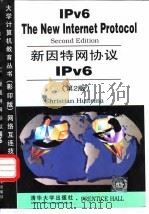《新因特网协议 IPv6 第2版》
| 作者 | (美)(C.胡依特马)Christian Huitema著 编者 |
|---|---|
| 出版 | 北京:清华大学出版社 |
| 参考页数 | 247 |
| 出版时间 | 1999(求助前请核对) 目录预览 |
| ISBN号 | 7302035474 — 求助条款 |
| PDF编号 | 86643088(仅供预览,未存储实际文件) |
| 求助格式 | 扫描PDF(若分多册发行,每次仅能受理1册) |

Chapter1Introduction1
1.2 为什么要使用调制解调器1
第1章关于调制解调器1
1.1 什么是调制解调器1
1.3 调制解调器能做什么2
1.1 Preparing for a Decision2
1.4.1 串行通信3
1.4 调制解调器基础3
1.4.4 传输速率4
1.4.3 通信方式4
1.4.2 异步通信与同步通信4
1.2 Two Years of Competition4
1.4.5 调制方法5
1.3 The New Specifications6
1.4.6 差错检测与纠错6
1.4.7 串行接口标准7
1.4 Points of Controversy7
1.5 Further Reading7
1.4.8 文件传输协议9
2.1 The Ipv6 Header Format9
Chapter2The Design of Ipv69
2.1.1 A Comparison of Two Headers10
1.4.9 CCITT制定的调制解调器标准11
2.1.2 Simplifications11
1.6 调制解调器的分类12
2.1.3 Classic Parameters,Revised12
1.5 传真调制解调器12
1.7 调制解调器命令集13
1.7.1 AT命令格式13
1.7.2 结果码13
1.7.3 AT命令的使用14
2.2 From Options to Extension Headers14
2.1.4 New Fields14
2.2.1 A Daisy Chain of Headers15
2.2.2 Routing Header17
第2章如何选择合适的调制解调器18
2.1 明确自己的需求18
2.2.3 Fragment Header19
2.2 衡量调制解调器性能的几个主要指标19
2.2.1 调制解调器的速度19
2.2.4 调制解调器的功能20
2.2.3 调制解调器的兼容性20
2.2.2 所支持的调制解调器标准20
2.2.4 Destination Options Header20
2.2.6 调制解调器文档是否完整21
2.2.5 调制解调器软件21
2.3.2 调制解调器流行品牌22
2.3.1 调制解调器市场现状22
2.3 调制解调器市场现状及流行品牌22
2.4 选购调制解调器的注意事项23
2.4.1 选购调制解调器硬件23
2.2.5 Hop-by-Hop Options Header23
2.4.2 选购调制解调器软件25
2.2.6 Extension Header Order25
2.5 调制解调器的新发展26
2.3 The Evolution of ICMP26
第3章调制解调器的安装与测试27
3.1 必要知识27
2.3.1 Error Messages27
2.3.2 The Ipv6 Ping29
2.4 Impact on the Upper Layers30
2.4.1 Upper-layer Checksums30
3.2 安装外部调制解调器30
3.2.1 准备开始安装30
3.2.2 安装步骤31
2.4.2 Ipv6 in the Domain Name Service32
3.3 安装内部调制解调器32
2.4.3 The Programming Interface33
3.4 安装通信软件33
3.5 快速测试调制解调器34
第4章学用DOS通信软件35
4.2 学用Procomm35
4.2.2 安装Procomm35
4.2.1 关于Procomm通信软件35
4.1 DOS流行通信软件35
2.5.1 Do We Need More Than 255 Hops?36
2.5 Points of Controversy36
4.2.3 启动Procomm36
2.5.2 Is The Destination Address in the Right Place?37
4.2.4 设置通信参数37
2.5.3 Should Packets Be Larger Than 64K?38
4.2.5 设置菜单38
2.5.4 Can We Live without a Checksum?39
2.5.5 What Should Be the Structure of the Routing Header?40
4.2.6 手工拨号40
2.5.6 Should the DNS Representation Be More Flexible?41
4.2.7 设置拨号目录——用号码簿拨号42
4.2.8 Procomm应用举例——两台PC机通信43
2.6 Further Reading43
4.3.3 启动SmartcomⅢ和获得帮助44
4.3.1 关于SmartcomⅢ44
4.3.2 安装SmartcomⅢ44
Chapter3Routing and Addressing45
3.1 Address Architecture45
4.3.4 设置任务和连接45
3.1.1 Notation of Ipv6 Addresses46
4.3.5 磁盘操作47
3.1.2 Initial Assignment48
4.3.6 信息传输48
4.3.7 其他功能简介49
3.1.3 Aggregatable Global Unicast Addresses50
4.4.1 安装DOS版QuickLinkⅡFAX52
4.4.2 启动DOS版QuickLinkⅡFAX52
4.4 学用DOS版QuickLinkⅡFAX52
4.4.3 设置通信参数53
3.1.4 Special Address Formats53
4.4.4 拨号连接54
4.4.5 接收文件54
4.4.6 发送文件54
3.1.5 Test Addresses54
4.4.7 捕获文本54
4.4.8 接收传真55
4.4.9 发送传真55
4.4.10 查看、打印和删除传真55
4.4.11 退回QuickLinkⅡFAX55
3.2 Multicasting and Anycasting55
3.2.1 Structure of Multicast Addresses56
5.2.2 设置通信参数56
第5章学用Windows通信软件56
5.1 Windows通信软件简介56
5.2 学用Windows终端仿真程序56
5.2.1 启动终端仿真程序56
5.2.4 发送文件57
5.2.5 接收文件57
5.2.3 拨号连接57
5.2.6 断开连接58
3.2.2 Structure of the Group Identifiers58
5.3.2 安装Smartcom for Windows LE58
5.3.1 关于Smartcom for Windows LE58
5.3 学用Smartcom for Windows LE58
5.3.3 启动Smartcom for Windows LE58
5.3.4 设置Smartcom for Windows LE59
3.2.3 Group Management62
3.2.4 Multicast Routing63
5.3.5 使用电话簿63
5.3.6 建立连接63
3.2.5 Anycast64
5.4.1 关于Smartcom FAX for Windows64
5.3.7 发送文件64
5.3.8 自动接收文件64
5.4 学用Smartcom FAX for Windows64
5.4.2 安装Smartcom FAX for Windows64
5.4.4 启动Smartcom FAX65
3.3 Inter-domain Routing65
5.4.5 安装Smartcom FAX65
5.4.3 设置调制解调器65
3.3.1 From CIDR to Providers66
5.4.6 发送传真67
5.4.7 接收传真67
5.4.8 查看和打印传真67
6.1 BBS简介68
6.2 BBS的特点68
第6章使用电子公告牌系统(BBS)68
3.3.2 From BGP-4 to IDRP68
6.3 BBS的应用69
6.4.2 业余BBS台70
6.4.1 160新先导台70
6.5 使用BBS70
6.4 典型中文BBS台70
6.6 使用BBS的注意事项71
6.5.2 BBS登录71
3.3.3 Provider Selection71
6.6.2 BBS使用规划71
6.6.1 与BBS设置匹配71
6.5.4 断开连接71
6.5.3 与BBS交流信息71
6.5.1 拨号连接BBS71
3.4.1 Updating OSPF73
第7章如何连接Internet73
7.1 Internet总览73
7.1.1 历史回顾73
7.1.2 Internet的现状73
7.1.3 Internet的未来73
3.4 Intra-domain Routing73
3.4.2 Updating RIP74
7.1.4 Internet地址74
7.1.5 Internet资源76
3.4.3 Other Protocols76
7.1.6 Internet网络服务77
3.5 Points of Controversy77
3.5.1 The Length of Addresses77
7.1.7 WWW中的几个重要术语78
7.1.8 TCP/IP简介79
7.2 Internet在中国的发展79
3.5.2 Providers and Monopolies79
7.3 中国公用Internet网——CHINANET80
3.5.3 Flows and Services80
8.2 UNIX FTP80
3.5.4 Variable Formats and Renumbering81
7.4 中国教育科研网——CERNET81
7.5 如何连接Internet82
7.5.1 终端用户接入方法82
7.5.2 局域网接入方式83
7.5.3 CHINANET提供的放入网方式83
3.5.5 From8+8 to GSE83
7.6 拨号连接和退出Internet主机84
7.5.4 CHINANET电话拨号用户入网条件84
7.6.1 拨号连接网上UNIX主机84
7.7 常用UNIX命令85
7.6.2 退出UNIX主机和断开连接85
3.5.6 End-point Identifiers and TCPng87
3.6 Further Reading88
8.1 UNIX Telnet89
第8章UNIX系统Internet工具89
8.4 UNIX电子邮件91
8.3 匿名FTP91
Chapter4Plug and Play91
4.1.1 Link Local Addresses92
8.4.3 常用Mail命令92
8.4.2 阅读电子邮件92
8.4.1 发送电子邮件92
4.1 Autoconfiguration92
8.5 UNIX新闻阅读器93
8.5.1 USENET简介93
4.1.2 Stateless Autoconfiguration94
8.5.2 使用rn94
8.5.3 使用nn95
8.6 UNIX Gopher96
8.7 UNIX WWW浏览器——Lynx96
4.1.4 Stateful Configuration97
4.1.3 Duplicate Detection97
4.1.5 Lifetime of Addresses98
9.1.2 安装和使用EWAN98
9.1 Windows Telnet98
第9章Windows系统Internet工具98
9.1.1 获取Windows Telent98
9.2 Windows FTP99
9.2.1 获取Windows FTP99
9.2.2 安装和使用WS_FTP99
4.1.6 Dynamic Host Configuration100
9.3 Windows电子邮件102
9.3.1 获取Windows电子邮件程序102
9.3.2 安装和配置Eudora102
9.3.3 使用Eudora103
9.4 Windows Gopher104
9.4.1 获取Windows Gopher104
9.4.2 安装和使用HGopher104
9.4.3 安装和使用WSGopher105
9.5.1 获取Windows新闻阅读器106
9.5 Windows新闻阅读器106
9.5.2 使用Win Trumpet106
4.2 Address Resolution106
4.1.7 Updating the Name Servers106
9.6 Windows WWW浏览器107
9.6.1 获取Windows WWW浏览器107
9.6.2 获取和安装Windows Mosaic108
9.6.3 使用Windows Mosaic108
4.2.1 The Basic Algorithm108
10.2.1 获取Netscape111
4.2.2 Redirects111
10.1 Netscape简介111
10.2 获取和安装Netscape111
第10章学用Netscape111
10.2.2 安装Win32s112
10.2.3 安装Netscape Navigator112
10.2.4 获取Win32s112
10.3 Netscape主屏幕113
10.3.1 Netscape主屏幕简介113
10.3.2 使用工具栏113
4.2.3 The Case of Nonconnected Networks113
4.2.4 Getting Information from Routers113
10.4.2 组织书签114
10.4.1 创建书签114
10.4 创建和组织书签114
10.3.3 浏览WWW资源114
10.5.2 使用Yahoo115
10.5 使用Netscape查询Web信息115
4.2.5 Black Hole Detection115
10.5.3 查询Web115
10.5.4 使用WAIS查询数据库115
10.5.1 Web信息查询工具115
10.5.5 使用Whois找人116
4.2.6 Random Delays116
10.7.1 创建E-mail116
10.7 使用Netscape发送电子邮件116
10.6.2 查询Gopherspace116
10.6.1 连接Gopher网点116
10.6 使用Netscape访问Gopher网点116
10.8 使用Netscape传输文件117
10.7.2 延迟发送E-mail117
10.8.1 使用Archie查询文件117
10.8.2 下载Web网点的文件117
10.8.3 下载FTP网点的文件117
4.2.8 Controlling Router Advertisements117
4.2.7 Protection Against Off-link Messages117
10.9 Netscape的其他功能118
第11章使用Windows 95漫游Internet119
11.1 安装配置Windows 95119
11.1.1 入网条件119
11.1.2 安装TCP/IP客户119
4.3.1 Serial Links119
4.3 Advanced Features119
11.1.4 建立SLIP/PPP连接120
11.1.5 建立Dial-UP Networking120
4.3.2 Nonbroadcast Multiple Access120
11.1.3 调制解调器设置120
11.1.6 使用Internet Setup Wizard121
11.2 使用拨号网络连接Internet121
4.3.3 Anycast Servers121
11.4 使用MS Exchange发送E-mail122
11.4.1 MS Exchange简介122
11.3 使用Windows 95 FTP下载文件122
11.4.3 创建地址簿122
4.3.5 Multi-homed Hosts122
4.3.4 Proxy Servers122
11.4.2 配置MS Exchange122
11.6 使用The MS Network连接Internet123
11.5.2 使用Internet Exploer123
11.5.1 Internet Explorer简介123
11.5 使用MS Internet Explorer漫游Internet123
11.4.5 查看E-mail123
11.4.4 发送E-mail123
11.6.1 The MS Network简介123
11.6.2 使用MSN连接Internet124
4.3.6 Changing Interface Boards124
4.3.7 Handling of Mobile Nodes in IPv6124
12.1.2 服务的高可靠性125
12.1.3 提高网络的经济效益125
12.1.1 网络用户的要求125
12.1 为什么要引入调制解调器网络管理系统125
第12章调制解调器的网络管理系统125
12.2 调制解调器网络管理系统的基本功能126
12.2.1 故障管理126
12.2.2 配置管理126
12.2.3 性能管理126
12.2.4 安全管理126
4.4.1 IPv6 over Ethernet126
4.4 Mapping to Specific Link Technologies126
12.2.5 计费管127
12.3 调制解调器网络管理的主要技术127
12.3.1 SNMP简介127
4.4.2 IPv6 over FDDI127
12.3.2 SNMP实现128
12.3.3 Modem的SNMP管理技术128
4.4.3 IPv6 over Token Ring129
12.4.3 HP Open View131
12.4.2 ERICSSON调制解调器网络管理系统131
12.4.1 Motorola调制解调器网络管理系统131
12.4 典型调制解调器网络管理系统介绍131
4.4.4 IPv6 over PPP131
13.2.1 调制解调器故障132
13.2 硬件故障和处理132
13.1 简介132
第13章调制解调器故障诊断和处理132
13.2.3 计算机串行端口COM故障133
4.4.5 IPv6 over ATM133
13.2.2 串行电缆故障133
13.3.1 与操作系统有关的问题134
13.3 软件故障和处理134
13.2.4 硬件安装和设置故障134
13.3.2 通信软件的安装设置问题135
13.3.3 通信过程中出现的问题136
13.4 电话线路故障和处理136
4.5 Points of Controversy137
4.5.1 Why Not Just ARP?137
13.5 其他问题与解答137
第14章节省开支的技巧138
14.2 节省软件开支138
14.2.1 选用免费或共享软件138
14.2.2 选用合适的文件传输协议138
14.1 节省硬件开支138
14.1.1 调制解调器速度138
14.1.2 调制解调器功能138
14.1.3 选择合适的通信时间138
4.5.2 Broadcasting or Multicasting?138
14.2.3 脱机处理139
14.3 使用文件压缩工具139
14.3.1 文件压缩工具简介139
4.5.3 Should We Support Mobility?139
14.3.2 使用WinZip140
14.3.3 使用PKZip140
4.5.4 Router Configuration140
4.5.5 Specifying the Hop Limit141
4.6 Further Reading142
Chaper5Bringing Security to the Internet145
5.1 Encryption and Authentication146
5.1.1 Security Association146
5.1.2 Authentication Header146
5.1.3 Computing the Authentication Data148
5.1.4 Encrypted Security Payload150
5.2 Key Distribution153
5.1.5 Authentication and Confidentiality153
5.2.1 Photuris154
5.2.2 SKIP156
5.2.3 ISAKMP-OAKLEY158
5.2.4 Manual Key Distribution161
5.2.5 Key Distribution for Multicast Groups161
5.3 Usage of IPv6 Security161
5.3.1 Steel Pipes and Firewalls162
5.3.4 Neighbor Discovery163
5.3.3 Secure Hosts163
5.3.2 Mobile Hosts163
5.3.5 Routing Protocols164
5.4 Points of Controversy165
5.4.1 Should We Mandate Security?165
5.4.2 Did We Choose the Correct Algorithm?167
5.4.3 Is This the Right Layer?169
5.4.4 Do We Need Additional Protection?169
5.5 Fruther Reading170
6.1 An Elusive Specification173
Chapter6Real-time Support and Flows173
6.1.1 Defining Folw Labels and Priorities174
6.1.2 Flows and Policy Routes174
6.1.3 Flows,Not Virtual Circuts175
6.2 Supporting Reservations175
6.2.1 Special Services176
6.2.2 Using RSVP and Flows177
6.2.3 Using Hop-by-Hop Options178
6.3 Hierarchical Coding and Priorities179
6.3.1 Hierarchical Transmission180
6.3.2 Large Multicast Groups Don t Need Priorities181
6.3.3 Source-relative Priorities Encourage Congestion183
6.3.4 Adaptive Applications184
6.3.5 Policing Network Usage185
6.3.6 Revising the Priority Field187
6.4 Points of Controversy188
6.4.1 Will Flow Labels Be Used?189
6.4.2 To Reserve or Not?190
6.4.3 What about ATM?192
6.5 Further Reading194
7.1.1 Supporting Two IP Layers197
7.1 Dual-stack Strategy197
Chapter7Transitioning the Internet197
7.1.2 Name Servers and Decisions199
7.1.3 Critical Points of Transition200
7.2 Building the 6-Bone201
7.2.1 Choosing the MTU202
7.2.2 Tunnels and Routiong Protocols203
7.2.3 Time to Live in a Tunnel204
7.2.4 Controlling the Tunnel s Share205
7.2.5 Digging Tunnels and Closing Them206
7.3.1 Reaching the Ipv6 Internet207
7.3 Connecting End Stations207
7.3.2 Reaching Isolated Hosts208
7.3.3 MTU and TTL Values for Automatic Tunnels210
7.3.4 Configurations and Decisions211
7.4 Early Deployment212
7.4.1 The Phases of the 6Bone213
7.4.2 Joining the 6Bone214
7.4.3 6Bone Addresses216
7.5 Points of Controversy217
7.5.1 Should We Perform Translations?217
7.5.2 Security Risks of Tunnels219
7.5.3 Life After Doomsday220
7.6 Further Reading221
Chapter8A Provisional Conclusion223
8.1 The Right Solution223
8.2 The Right Time225
8.3 Milestones227
8.4 The Future Will Tell228
Glossary229
Index241
1999《新因特网协议 IPv6 第2版》由于是年代较久的资料都绝版了,几乎不可能购买到实物。如果大家为了学习确实需要,可向博主求助其电子版PDF文件(由(美)(C.胡依特马)Christian Huitema著 1999 北京:清华大学出版社 出版的版本) 。对合法合规的求助,我会当即受理并将下载地址发送给你。
高度相关资料
-

- 计算机网络与因特网
- 1998 北京:清华大学出版社
-

- 因特网霸:上网秘笈
- 北京:电子工业出版社
-

- 漫步因特网 Internet
- 1998 北京:人民交通出版社
-

- 因特网应用教程 Internet
- 1999 北京:科学出版社
-

- 因特网实用技术
- 1998 武汉:湖北科学技术出版社
-

- 漫游因特网
- 1999 北京:人民邮电出版社
-

- 因特网的使用
- 1998 武汉:湖北科学技术出版社
-

- 因特网 Internet 教程
- 1999 北京:清华大学出版社
-

- 因特网Internet
- 1997 北京:教育科学出版社
-

- 漫游因特网
- 1999 南京:江苏科学技术出版社
-

- 连入因特网 从视窗95中访问因特网
- 1998 武汉:武汉测绘科技大学出版社
-

- 因特网上的通信
- 1999 南京:江苏科学技术出版社
-

- 走进因特网
- 1998 上海:上海交通大学出版社
-

- 因特网常用工具
- 1999 南京:江苏科学技术出版社
提示:百度云已更名为百度网盘(百度盘),天翼云盘、微盘下载地址……暂未提供。➥ PDF文字可复制化或转WORD
